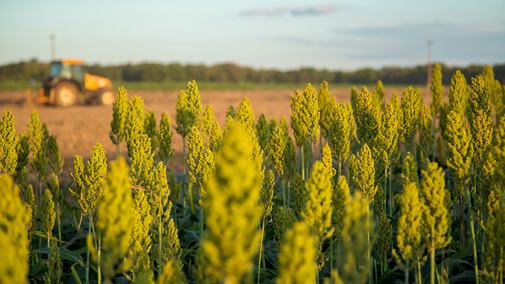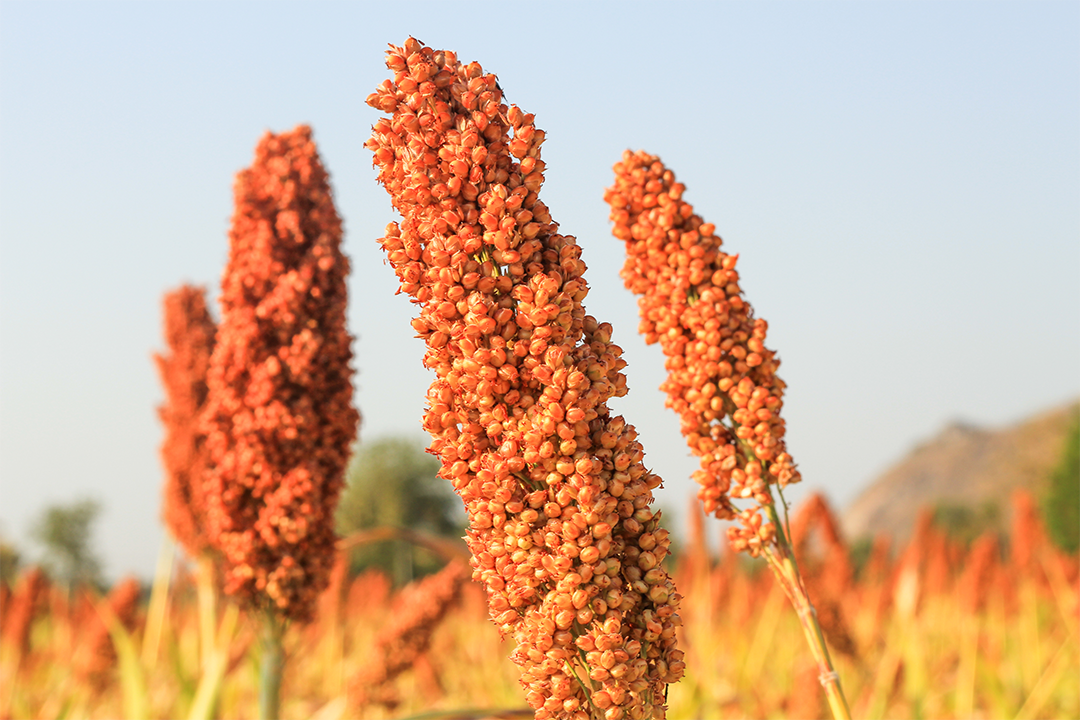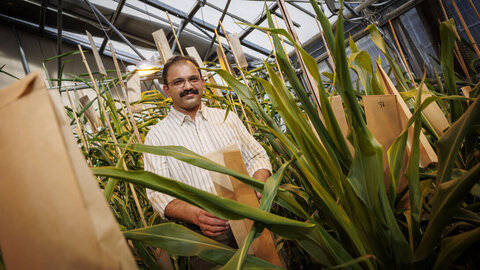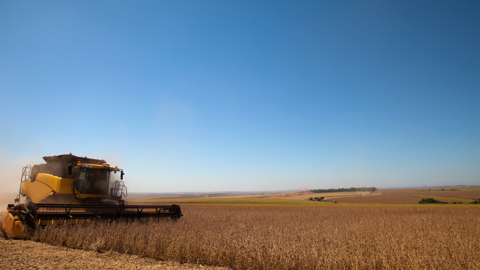
Nebraska Sorghum Production
Nebraska ranks 5th in U.S. sorghum production and is primarily grown in the southern region of the state. In 2023, Nebraska's sorghum production resulted in $75.9 million from 225,000 acres harvested, according to USDA National Agricultural Statistics Service.

Sorghum Production Resources
In-Season Resources
Hybrid Selection and Seeding Population
Select a top performing hybrid from one of the seed companies who are proud to sell milo seed. Don't be afraid of taller hybrids. Many times these are top performers and height is not a real issue with today's combines and is not closely related to stalk rot or standability. Plant 80,000 plants per acre on dryland in any row spacing in Gage County and drop the population 5000 plants per acre for every county west across southern Nebraska.
Crop Rotation Considerations
Results from a crop rotation study conducted by Paul Hay from 1994-2005.
Fertilize for Top Yields
Milo needs 1.1 pounds of nitrogen per bushel for top economic production. Soil test levels and past yield goals will tell you the nitrogen fertilizer addition you will need and the response you might expect from phosphorus and zinc. Check out the sorghum soil management page for current University of Nebraska-Lincoln Extension recommendations for nitrogen, phosphorus, potassium, zinc, iron, and sulfur. If the phosphorus level in the field is low, starter fertilizer is an excellent way to get the phosphorus efficiently placed for top response. Because of the great reliance on postemergent herbicides for weed control, starter fertilizer usually helps produce a larger plant sooner and aids in the weed control.
Please click here for information on a no-till sorghum starter fertilizer study.
Limit Tillage
Milo yields have been excellent under no-till systems. If you feel you have to part the residue, do so without moving soil. This helps to take the E (evaporation) out of ET (evaporation & transpiration), which are the water use components. Crop residue does this in two ways. It eliminates the moisture lost from every tillage operation which amounts to one-fourth inch to one inch depending on timing and depth. Residue also shades the soil and reduces evaporation loss from the soil surface. Residue cover keeps the soil temperature a bit cooler and reduces stalk rot problems. This is particularly true as you move west in Nebraska to dryer and warmer summertime soil temperatures.
Weed Control
The keys to weed control in milo are Early Pre-plant (EPP) and Days Before Planting (DBP) listed in the University of Nebraska-Lincoln Extension Guide for Weed Managemen (See the Sorghum Weed Management section). There are few options for post emergence grass control until Clearfield hybrids become available. So a solid before planting program is the best.
What about a burndown with glyphosate at planting or pre-emerge treatment? It can work, but there is a dangerous gap. Grass killers for sorghum are shoot absorbed. If there is no rain to activate the herbicide, escapes can occur where there is a bit of moisture in the soil to germinate grasses which come through the non-active barrier. When the herbicide is in place for the later planted crop, it saves moisture and gives the producer added options for both grass and broadleaf control. Spraying the last part of the herbicide behind the planter and/or using glyphosate behind the planter extends the weed control program and ensures a clean field at planting without using tillage to dry the soil and plant more weed seed. There are limited options for post grass control so scout heavy early and respond aggressively to escapes while they are small.
Insect Considerations
July is greenbug month. You have to scout fields carefully during July and make a decision on greenbug control. Treatments in August most often kill the greenbugs after the damage has been done.
Trifold Chinch Bug Plan: Chinch bugs are a threat to sorghum at three stages. One, in the seedling stage when chinch bugs are present because of poor control or too late control of grasses like volunteer wheat. Two, when wheat or oats ripen and the chinch bugs march across to the milo field next door. Three, after heading when the second generation flies into the milo field and sets up housekeeping. Stay alert and do the best you can to choose treatment options for this troublesome pest. Seed treatment insecticides can help in the seedling stage and to a lessor extent after the wheat ripens. Kansas trials are often more promising than Nebraska experience because Nebraska milo producers have a longer time between milo planting and wheat ripening, which challenges the endurance of the insecticides.
Timely Harvest
Part of treating milo as a second choice is to let it stand to dry while getting the corn harvested before the itching starts. This is not the way those choices should be made. In all management decisions including harvest, the milo producer who treats it a first class crop is going to be more successful. Milo packs denser in bins so it must be drier than corn for safe moisture levels for aeration only. With good aeration you can keep the fans running and handle corn at 19-20%, but milo at 17-18% is about as high as you should go. It is very important in either case to take a load out of the bin after filling to take the cone down (level the bin) and remove fines from the grain spreader out of the center of the bin.
Forage Sorghum Production Tips
Forage sorghum can be a good crop to use in rotations to break insect and disease cycles that may develop in continuous corn.
Related Resources
- Grain Sorghum Production Handbook, Kansas State University
- Sorghum Production for Maximum Yields — Kraig Rooseboom, Kansas State University Department of Agronomy
- Cover Crop Effect in Sorghum-Soy-Wheat Rotation — Kraig Rooseboom, Kansas State University Department of Agronomy
- Additional sorghum production information can be found at the United Sorghum Checkoff Program Website and YouTube site.
- USCP Central & Eastern Plains Production Handbook
- USCP Eastern Forage Production Guide
- USCP Western Forage Production Guide
Sorghum Profitability Resources
Sorghum Profitability Seminar Presentations
2017 Nebraska Sorghum Symposium Video Presentations (on YouTube)
- Getting to Know Sorghum — Brent Bean, agronomist with the United Sorghum Check-off Program
- Managing Key Inputs in Sorghum Production — Rick Kochenower, national agronomist with Chromatin, Inc.
- Reducing Input Costs in Sorghum Production — Bob Klein, Nebraska Extension cropping systems specialist for western Nebraska
- Weed Control and Herbicide Resistant Weeds — Rodrigo Werle, Nebraska Extension cropping systems specialist
- Weather Outlook for the 2017 Sorghum Season — Al Dutcher, associate state climatologist
2015 Presentations
- How to Manage Sorghum for Peak Performance — Brent Bean, Agronomist USCP
- Importance of Improving Soil Health — Dan Gillespie, NRCS
- Limited Irrigation of Sorghum — Chuck Burr, Nebraska Extension Educator
- Spotlight on Sorghum — Jesse McCurry, United Sorghum Checkoff Program (USCP)
2013 Presentations
- Nutrient Management-N, P, Soil Testing — Charles Wortmann, UNL Agronomy & Horticulture
- Sorghum's Crop Water Use Efficiency/Limited Irrigation — Jenny Rees, UNL Extension
- Sorghum Feed & Forage Value — Karla Jenkins, UNL Panhandle R & E Center
- Sorghum Checkoff Update — Barbara Kliment, Nebraska Grain Sorghum Board
- Time to "Rethink" Sorghum Advanced Biofuels — Doug Bice, Abengoa Bioenergy
- Weather Outlook-Will the Drought Persist? — Al Dutcher, Associate Nebraska State Climatologist
- Sorghum Production Budgets — Roger Wilson, UNL Ag Economics
- Focus on Pheasants — Nebraska Game and Parks
Variety Test Plots
Nebraska Sorghum Board and Nebraska Sorghum Growers
- 2020 Trenton (irrigated) Plot
- 2020 Trenton (non-irrigated) Plot
- 2019 Trenton (non-irrigated) Plot
- 2018 Trenton (non-irrigated) Plot
- 2018 Trenton (irrigated) Plot
- 2018 Farwell (non-irrigated) Plot
- 2017 Trenton (non-irrigated) Plot Part 1
- 2017 Trenton (non-irrigated) Plot Part 2
- 2017 Trenton (irrigated) Plot
- 2017 Lawrence (non-irrigated)
- 2016 Trenton (non-irrigated) Plot Part 1
- 2016 Trenton (non-irrigated) Plot Part 2
- 2016 Farwell (irrigated) Plot
- 2016 St. Paul (irrigated) Plot
- 2015 Trenton (irrigated) Plot
- 2015 Trenton (non-irrigated) Plot-Page 1
- 2015 Trenton (non-irrigated) Plot-Page2
- 2015 Farwell (irrigated) Plot
- 2015 Farwell (non-irrigated) Plot
- 2015 St. Paul (irrigated) Plot
- 2014 Sterling Plot
- 2014 Trenton Plot
- 2012 Blue Hill Plot
- 2012 Trenton Plot
Sorghum Variety Test Plots
Nebraska Sorghum Board and Nebraska Sorghum Growers
- 2020 Trenton (irrigated) Plot
- 2020 Trenton (non-irrigated) Plot
- 2019 Trenton (non-irrigated) Plot
- 2018 Trenton (non-irrigated) Plot
- 2018 Trenton (irrigated) Plot
- 2018 Farwell (non-irrigated) Plot
- 2017 Trenton (non-irrigated) Plot Part 1
- 2017 Trenton (non-irrigated) Plot Part 2
- 2017 Trenton (irrigated) Plot
- 2017 Lawrence (non-irrigated)
- 2016 Trenton (non-irrigated) Plot Part 1
- 2016 Trenton (non-irrigated) Plot Part 2
- 2016 Farwell (irrigated) Plot
- 2016 St. Paul (irrigated) Plot
- 2015 Trenton (irrigated) Plot
- 2015 Trenton (non-irrigated) Plot-Page 1
- 2015 Trenton (non-irrigated) Plot-Page2
- 2015 Farwell (irrigated) Plot
- 2015 Farwell (non-irrigated) Plot
- 2015 St. Paul (irrigated) Plot
- 2014 Sterling Plot
- 2014 Trenton Plot
- 2012 Blue Hill Plot
- 2012 Trenton Plot





